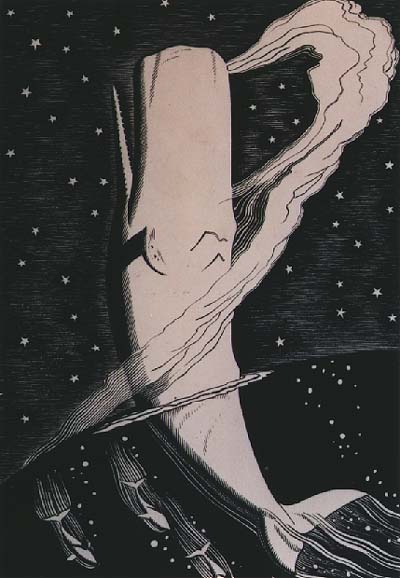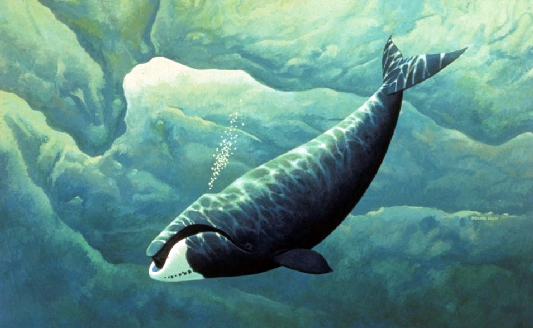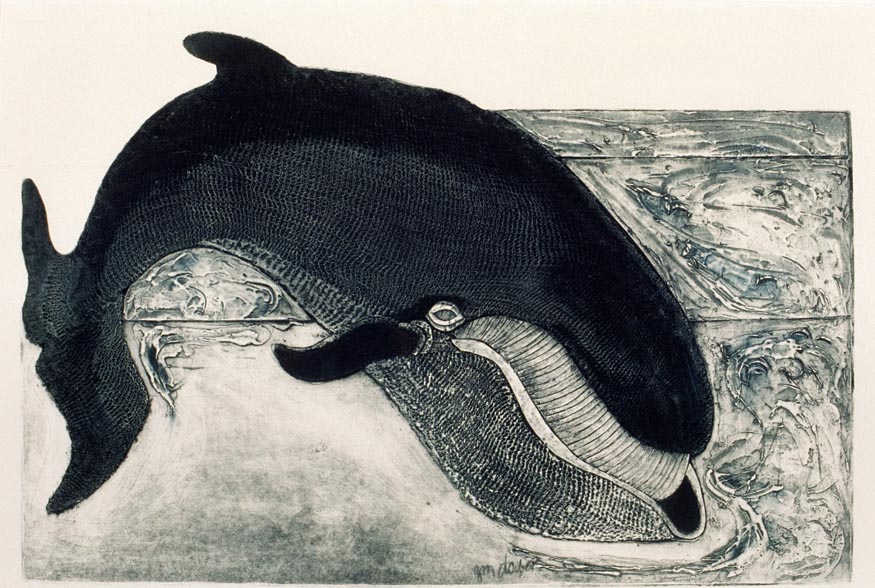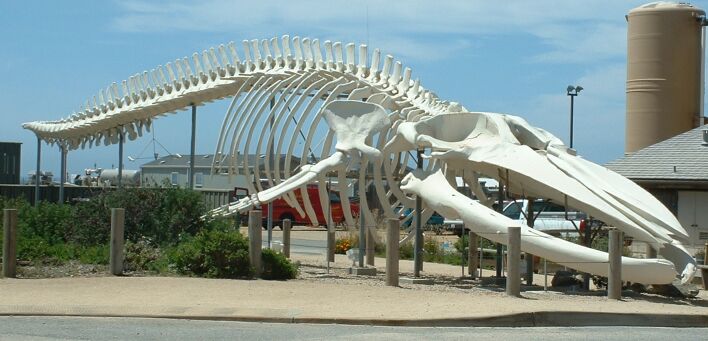The late actor, Heath Ledger, directed a music video, which was just released, of the song 'King Rat' for the American indie band Modest Mouse. In this youtube video posted by Spain's rtve you can see the full-length short. The video has created quite a buzz, focusing as it does on an anti-whaling message by reversing the roles hunter and hunted. Whales and dolphins harpoon swimming people, skin them and process them on board to turn them into treats for seals.
Rachel Cernansky of Planet Green writes, 'Watch it. It's intense. The video imagines a world in which whales hunt humans. But it's animated and it's beautifully done, and he pulls off sending a really effective message that we all need to hear, and take more action on, now. Despite decades of protective measures, things are not looking good for whales.'
For the first month of the release, proceeds from iTunes downloads will benefit Sea Shepherd, a marine wildlife conservation organization with which Ledger was involved. They write, 'Sea Shepherd Conservation Society is honored to be connected with this important work and hopes that it brings attention to the illegal slaughter of whales in the Southern Ocean Whale Sanctuary.'
Whales are marine mammals, but they are not dolphins or porpoises. In fact their nearest living relatives are hippos. They started out on land, but 50 million years ago they headed into the sea. Warm-blooded, they also breathe with lungs and nurse their young with milk from mammary glands.
No wonder these animals of mythic proportions grab our imagination and become the subject, direct or otherwise, of poets, novelists and playwrights. The stage, where no whale will ever set ‘foot’, seems the most unlikely venue for the subject, but a survey of the field reveals many whale productions. The plays range from children’s productions to one-person shows, performance pieces, small operas, and musicals.
| 'I still wish I had been there in 1955 when Orson Welles took over the Duke of York's Theatre and put on his own play (by way of Herman Melville) – Moby Dick Rehearsed – in which some New England villagers try to place Melville's epic novel on a tiny stage. There was no whale, no ocean, no ship – just valiant theatrical gestures towards those immense, unmanageable realities, and the Shakespearean dream of "a muse of fire" doing the rest...Those who saw it (it ran less than a month) say it was magic, with all the actors swaying in unison to suggest being on a ship at sea.' - David Thomson, Theatre Blog
|
This play about a group of New Englanders trying to rehearse a play based on Melville’s novel, ran originally for three weeks. It was also apparently filmed, but the film version is lost. In the play, the actors, who are expecting to rehearse King Lear are informed they will be doing Moby Dick instead. Dressed in street clothes, they start to improvise scenery – using brooms for oars, and a stick for a telescope, and eventually get into character. The cast included Orson Welles, Gordon Jackson, and Joan Plowright among others.
Moby Dick, the Musical
Robert Longden, Martin Koch, Hereward Kaye, 1991, 2008
Faced with the closing of their school, the girls of the St. Godley's Academy for Young Ladies stage a musical version of Moby Dick to try to raise enough money to save it.
Hereward Kaye’s website gives an accounting of the play's erratic history.

Moby Dick Rises, 1930, Rockwell Kent
copyright R. R. Donnelly and Sons Company
|
The Whale
Carl Adinolfi and the Concrete Temple Theatre
One-man show
June, 2003 premiere
78th Street Theatre Lab, NYC
Toured India and Sri Lanka 2008
At the Barrow Street Theatre January 2009
Starting in 1995, this play underwent many forms and names: Moby Dick, Ahab and One Man Moby Dick, before it settled on The Whale for its 2003 premiere.
"When Moby Dick itself rises up from nowhere with fearsome power, it is easy to forget this is all in the mind, and you can almost taste the salt as you drown in the deep waters of Adinolfi's imagination."
- Jeremy Hodges, The Daily Mail
“Using only his body, voice, and an extraordinary collection of hand-crafted and rigged props to create life on a whale ship [Carlo] Adinolfi, a dancer and actor by training, puts into service a variety of storytelling traditions. The effect of one man embodying this enormous literary epic in 60 minutes (using Melville's text) is simultaneously playful and profound.” Philip Fisher, British Theatre Guide
And God Created Great Whales
Rinde Eckert
July 11, 2000 premiere at Dance Theater Workshop's Bessie Schonberg Theater
| Whale oil used to light the lamps at theatres in the early 1800s. When a theatre in Philadelphia decided to switch to gas, it caused a ruckus - but it also made the stage a lot brighter.
|
Nathan, a writer with a fatal disease and degenerative memory loss is struggling to finish an opera based on the novel Moby Dick. He wanders the stage with a tape recorder slung around his neck, to remind him of things he has already forgotten.
“…the 80-minute music-theater piece, in which he sings, speaks and plays the piano and ukulele, stands in a clear relation to the epic but ramifies it in completely different ways.'' - New York Times
Review by Kate Bassett here

Bowhead Whale Diving copyright Richard Ellis
|
The Whale
The Moby Dick Project
Mixed Magic Theatre
November 15, 2008
“A simultaneous telling of two stories that take place on the decks of the infamous Pequod. One story follows Ahab and his crew on the epic quest to kill the whale while the other is a modern tale of an inner-city youth gang led by a girl whose parents were killed in a drive-by shooting.” - mixedmagictheatre.org
Watch the entire one-hour performance at the Kennedy Center in Washington, D.C.
| Other whale links on the Ashden Directory: David Rothenberg's Thousand Mile Song
Helen East's storytelling The Narwhal
Other whale links on the web:
Review of Elin Kelsey's Watching Giants on economist.com
Heather Ackroyd and Dan Harvey's whale skeleton Stranded as part of the Cape Farewell Project, also here
|
Moby Dick
Adapted and directed by Morris Panych.
Premiered July 2008 at Stratford Shakespeare Festival, Ontario, Canada
Panych’s Moby Dick departs from the novel in one striking way: only the first three words in the book are uttered by an actor onstage. Other than some voice-over readings of the ship’s logs, the play is told completely through the music of Debussy and through movement. Simple props are used, including the actors’ wind-whipped clothes to portray the sails.
In the Belly of the Whale
Jonathan Bender, Solo performance
Premier January 10, 2008
“A secular spoken word poet mysteriously finds himself in the belly of a whale, where he encounters eight other characters, all with very different relationships to being Jewish. Ages 14 to 81, they include an atheist social activist, a rabbi, a teenage girl, a gay professor of Jewish studies, and a Holocaust survivor and his grandson.” Jewishtheatere.com
The Whale’s Tooth
July 2008, Clore Theatre, Nottingham
Interactive sensory theatre for people with profound and multiple learning difficulties, complex disabilities or an autism spectrum disorder
The Whale’s Tooth is about Canny – a young girl from the Arctic Circle and her grandfather. She is on a quest to find her father, who was presumed dead until his name was found carved on a whale’s tooth. Canny and her grandfather go on a dangerous journey to find him.

Blue Whale copyright G. M. Daiber
|
Epitaph for the Whales
Kujira no Bohyo
English translation of a Japanese play by Yoji Sakate
Premiered, 1993
Gate Theatre London, 1998
‘Epitaph for the Whales, which deals with the lives of seven whale-hunting brothers, was written and staged at the Suzunari Theatre in 1993, Tokyo, initiating Sakate’s series of Contemporary No Plays. He incorporated the conventions of no (Japan’s classical theatre), and blended aspects of fantasy and traditional culture in his own theatre. This new theatrical tool helped to enrich the art of Sakate’s theatre and to add to the plays maturity and subtlety… in Epitaph he focused his discussion on whaling, its community and family relationship. The play tells the story of this delicate issue from the traditional viewpoint of Japanese whalers, and the no conventions enforce this sense of tradition with its power of fantasy and romanticism.’ – Japan Foundation, Kuala Lumpur
There have been a number of children’s productions on the whale theme as well.
When the Whales Came (film 1989)
Why the Whales Came (play 2001)
At the National Theatre over Christmas 2008
Greg Banks' adaptation of Michael Morpurgo's novel
This is set in the Scilly Isles during World War I. Two friends try to unravel the mysteries of an abandoned island and to discover why the whales came.

Blue Whale skeleton, Long Marine Laboratory
University of California, Santa Cruz
|
Whale – The Story of Putu, Siku and K'nik
David Holman - National Theatre, Lyttleton, 1989;
Director: Richard Eyre
A play for 7-12 year olds, based on the events of October 1988 at Point Barrow, North Alaska, when three Californian grey whales were trapped under the ice.
Whale Song - an Oratorio for Children
Andrew Peggie & Stephen Clark
This oratorio is also based on the whales trapped in Barrow Alaska.
A trio of grey whales are trapped within a small patch of coastal sea which is rapidly freezing over. Local people try to cut a passage through the ice but their resources cannot cope. American forces are drafted in to help - and with them come news reporters and TV cameras The race against time becomes serious and, in a rare example of East-West collaboration, a Soviet ice-breaker joins the struggle. The smallest whale disappears before the completion of a passage - which then freezes over again before the others have reached the end. The assumption is that they find open sea but no-one can ever be sure. Whale Song recounts this remarkable true story as a musical parable of the benefits of co-operation and trust.
Internet, TV and film are other rich areas of research. Here's just a sampling of each.
The Secret Lives of Whales
Short Attention Span Science Theater
Streaming movie with four short pieces on whales and science
.

The Whaleboat, copyright Jay Wegter
Fort Guijarros Museum collection
|
Whale Wars
Animal Planet
Seven-part weekly series
Premiere November 14, 2008
"Whale Wars, which has its premiere Friday on Animal Planet, follows some nautical types as they go about their business, but these aren’t mere ice-road truckers or sandhogs (to mention the subjects of two shows on the History Channel). They are, in the opinion of some of their detractors, eco-terrorists: a band of self-appointed warriors determined to stop the killing of whales.” - New York Times
Whale Rider
2002 Directed by Niki Caro
This much-nominated and honored film, based on the novel by Witi Ihimaera, focused on a young Maori girl confronting the past and changing the future.
published in 2009
Phillip Hoare has won this year's Samuel Johnson prize, the UK's most important non-fiction prize, for his book Leviathan, or The Whale. The chairman of the judges predicted it would become 'a classic'.
Rachel Cooke reviewed Leviathan, or The Whale by Philip Hoare in The Guardian:
'...it is also an examination of humankind's tortuous relationship with the whale, for the creature that we have pursued and exploited almost to extinction inhabits our collective imagination like no other on this planet.'
'The passages in which he describes the 19th-century whale ships are marvellously exciting, yet full of pity: the tiny boats bobbing on the water; the terrible waiting ('An experienced whaler would know how long an animal would stay down by its size ... the longer they waited, the greater the monster they faced'); the moment of attack itself. Men would faint clean away, faced with a whale.'
'It was not until 1975, long after we had seen Earth from space, that a whale was first photographed under water; no wonder the creature exercised such a fierce hold over the minds of men.'
Leviathan author Philip Hoare has put together a top ten list of books on whales for The Guardian:
Moby-Dick by Herman Melville
The Natural History of the Sperm Whale by Thomas Beale
An Account of the Arctic Regions by William Scoresby
Whale Nation by Heathcote Williams
The Year of the Whale by Victor B Scheffer
Sperm Whales: Social Evolution in the Ocean by Hal Whitehead
Whales' Bones of the British Isles by Nicholas Redman
In The Heart of the Sea by Nathaniel Philbrick
Whales: A Celebration by Greg Gatenby
A Guide to Marine Mammals of the World by Randall R Reeves et al
|